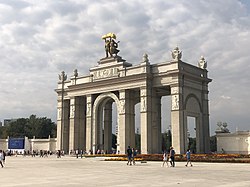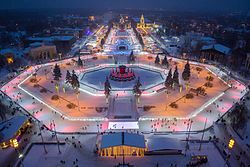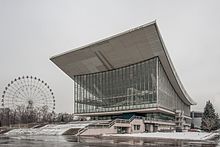Exhibition of Achievements of National Economy
You can help expand this article with text translated from the corresponding article in Russian. (January 2017) Click [show] for important translation instructions.
|
| VDNKh | |
|---|---|
 The main entrance to VDNKh | |
 | |
| Location | Moscow, Russia |
| Coordinates | 55°49′47″N 37°37′56″E / 55.82972°N 37.63222°E |
| Opened | 17 February 1935 |
Former names | All-Union Agricultural Exhibition (VSKhV) |
| Enclosed space | |
| Website | |
| vdnh | |

Exhibition of Achievements of National Economy (Russian: Выставка достижений народного хозяйства, Vystavka dostizheniy narodnogo hozyaystva, abbreviated as VDNKh or VDNH, Russian: ВДНХ, pronounced [vɛ dɛ ɛn xa]) is a permanent general purpose trade show and amusement park in Moscow, Russia.[1] Between 1991 and 2014, it was also called the All-Russia Exhibition Centre (Russian: Всероссийский выставочный центр). It is a state joint-stock company.
Location and transportation
VDNKh is located in
History
1935–1939 construction
The exhibition was established February 17, 1935 as the All-Union Agricultural Exhibition (VSKhV) (Russian: Всесоюзная сельско-хозяйственная выставка; Vsesoyuznaya selsko-khozyaystvennaya vystavka). An existing site (then known as Ostankino Park, a country territory recently incorporated into the city limits), was approved in August 1935. The master plan by Vyacheslav Oltarzhevsky was approved in April 1936, and the first show season was announced to begin in July 1937 and was designed as a "City of Exhibitions" with streets and public spaces, which was very common in the 1930s. However, plans did not materialise, and three weeks before the deadline Joseph Stalin personally postponed the exhibition by one year (to August 1938). It seemed that this time everything would be ready on time, but again the builders failed to complete their work, and regional authorities failed to select and deliver proper exhibits. Some pavilions and the 1937 entrance gates by Oltarzhevsky were torn down to be replaced with more appropriate structures (most pavilions were criticised for having no windows). According to Oltarzhevsky's original plan, all of the pavilions were to be constructed from wood. In 1938, a government commission examined the construction and decided that it did not suit the ideological direction of the moment. The exhibition was considered too modest and too temporary. Oltarzhevsky was arrested, together with the Commissar for Agriculture and his staff, and eventually released in 1943. Later, he worked on the 1947-1953 Moscow skyscraper project.[2]
As a result, in August 1938 Nikita Khrushchev, addressing the assembled Supreme Soviet of the Soviet Union, declared that the site was not ready, and the opening was postponed until August 1939. It finally opened on 1 August 1939, and was open to the public until 25 October. The 1940 and 1941 seasons followed but following German invasion in 1941 the exhibition was closed until the end of World War II.
1939 pavilions, as presented in 1950 album and today:
-
Pavilion of Kyrgyzstan
-
Pavilion of Belarus
-
Pavilion of Uzbekistan
-
Pavilion of Karelia
-
Pavilion of Ukraine
-
Pavilion of North Caucasus
-
Pavilion of Turkmenistan
-
Pavilion of Armenia
1948–1959 renovation
In October 1948 the State ordered the renewal of the Exhibition, starting with the 1950 season. Again, the opening was postponed more than once; the first post-war season opened in 1954 (still as Agricultural exhibition). In the 1956 season the planners set aside an Industrial area within the main territory; more restructuring and rebuilding followed. In 1959 the park was renamed Exhibition of Achievements of the National Economy (Russian: Выставка достижений народного хозяйства, Vystavka dostizheniy narodnovo khozyaystva) or ВДНХ/VDNKh.

By 1989 the exhibition had 82 pavilions with an exhibition area of 700,000 square metres. Each pavilion (including the 1939 "regions") had been dedicated to a particular industry or field: the Engineering Pavilion (1954), the Space Pavilion (1966), the Central Industrial Zones Pavilion (1955), the Atomic Energy Pavilion (1954), the People's Education Pavilion (1954), the Radioelectronics Pavilion (1958), the Soviet Culture Pavilion (1964).
During Soviet times, each year VDNKh hosted more than 300 national and international exhibitions and many conferences, seminars and meetings of scientists and industry professionals. The most memorable feature of the exhibition site was the
Present day
In 1992, VDNKh was renamed, receiving the new acronym VVC, which remained in use until 2014. It occupies 2,375,000 square metres of which 266,000 square metres are used for indoor exhibits. The territory of VDNKh is greater than that of the Principality of
The "VDNKh" (or VVTs) complex still operates including the name of a nearby
Restoration
On 14 May 2014 the previous name VDNKh was restored, following an interactive poll.[4] In addition, the mayor of Moscow announced that the Russian space shuttle, the structural test article - TVA, which was an attraction and restaurant at Gorky Park in Moscow was to be moved to the VNDKh, to be displayed near the Vostok rocket in front of the Cosmos hall. It was moved 5–6 July 2014 and re-assembled by 21 July.[5]
In September 2018, Sergey Shogurov was appointed as CEO of VDNK. New museum and exhibition spaces were opened, a Landscape Park was created, and objects of cultural heritage were carried out, public electric transport was launched. In 2019, the restoration of the "Fraternity of peoples" and "Stone Flower" fountains was completed.[6]
-
Central Pavilion
-
Moscow-850 Ferris wheel
-
Pavilion "Agriculture"
-
The Pavilion of Atomic energy
-
The old entrance gate to the exhibition centre
-
Cirkorama theatre
-
The Cosmonautics and Aviation Centre located in the Cosmos pavilion
The site


The exhibition centre was built in the era of
The
See also
References
- ^ "About VDNH". Archived from the original on 2015-11-12. Retrieved 2015-10-30.
- ^ This section is based on Soviet public documents available in Russian at www.bcxb.ru Archived 2007-05-20 at the Wayback Machine
- ^ ""Рабочий и колхозница". Сложная судьба эталона соцреализма". РИА НОВОСТИ. 2007-04-11. Archived from the original on 19 August 2007. Retrieved 2007-08-09.
- ^ ВВЦ в Москве возвращено историческое название ВДНХ (in Russian). Interfax. 15 May 2014. Retrieved 15 May 2014.
- ^ Petrovitch, Vassili. "Transportation of the shuttle to the VNDKh park". Retrieved 21 February 2015.
- ^ "Гендиректор ВДНХ: очередной этап программы возрождения выставки успешно завершен - ТАСС". tass.ru. Archived from the original on October 7, 2021. Retrieved 2021-11-02.
- ^ "✈ russianplanes.net ✈ наша авиация".
External links
- Official website
- Map of the VDNH in infoservices website
- General information in russianmuseums website
- Virtual tours and panoramas of the VDNH
- VDNH in WikiMapiawebsite
- A comprehensive architectural history of the Exhibition in Russian
















